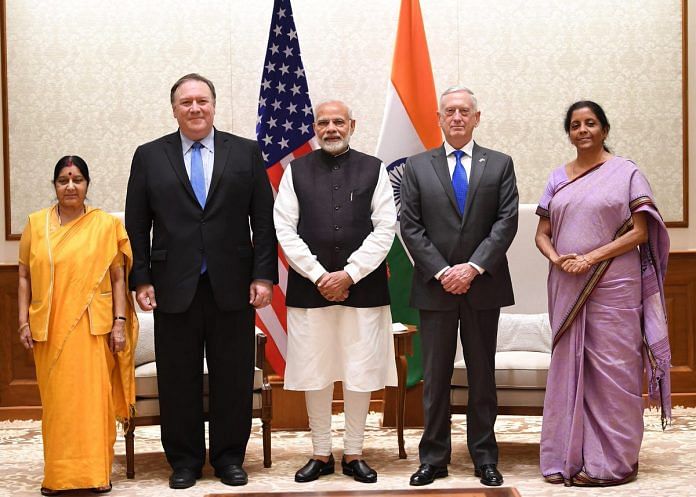US vows to bring India into NSG, turn blind eye to Delhi building Iran port & buying Russian missiles. In turn, it wants India to up defence purchases.
New Delhi: On the tenth anniversary of the Indo-US nuclear deal, India took another substantial leap into America’s orbit by agreeing Thursday to have its military share communication and intelligence with the US defence forces.
In exchange, the US committed to helping India become a member of the Nuclear Suppliers Group (NSG), and turn a blind eye to Delhi building the Chabahar port in Iran, and the purchase of S-400 surface-to-air missile systems from Russia as part of a $6 billion (Rs 40,000 crore) deal.
The latter two threatened to invite American sanctions for Delhi in keeping with a law that seeks to check international engagement with countries the US sees as enemies.
Also read: Modi and Trump may not get along, but India and US are best friends today
The Modi government’s decision to ramp up the defence relationship with the US is the new, big turn on India’s foreign policy front in the wake of the historic 2+2 summit Thursday.
The freedom to not agree
Following the summit between the foreign and defence ministers, Indian officials said talks had gone off well. Delhi is buoyed by the fact that US Secretary of State Mike Pompeo read the diplomatic version of the riot act to Pakistan en route to Delhi.
As Pompeo told American journalists: “In Pakistan yesterday (Wednesday), we agreed that it’s time to start delivering on our joint commitments.”
“There was broad agreement between myself, foreign minister (Shah Mahmood) Qureshi, and Prime Minister Imran Khan that we need to take steps that will deliver outcomes on the ground, allowing us to begin to build confidence and trust between our two countries,” he added.
Also read: For the first time, India & US agree to hold wargame with army, navy and airforce
On India going ahead with its decision to buy the Russian S-400 missile system, US Defence Secretary Jim Mattis admitted to the US press that “freedom means that, at times, nations don’t agree with each other”.
“That doesn’t mean we can’t be partners. That doesn’t mean we don’t respect the sovereignty of others,” Mattis added.
“…We do understand the history of India’s relationship with Russia and legacy systems,” he said.
“Our effort here is not to penalise great strategic partners like India, a major defence partner. The sanctions… are intended to have an impact on the sanctioned country, which is Russia,” he added.
Certainly, the Chinese have brought India and the US much closer. The Americans have decided that they cannot allow one Russian deal to come in the way of a much bigger relationship with India. Taking on China’s rising power is the much more important challenge.
From transport aircraft like C-17 Globemasters, to 28 AH-64E attack helicopters, 15 CH-47F Chinook heavy-lift helicopters and 24 MH-60 Romeo maritime helicopters, US defence equipment is slowly replacing Russian defence equipment in India.
Over the last 10 years, since the nuclear deal came into force, India has bought $18-20 billion worth of defence equipment from America.
The payback US seeks
The Americans are also believed to have come to terms with India building a port in Iran’s Chabahar, thereby busting US-led sanctions against Iran – clearly, the Indian port-building will be carried out with US permission.
And Mattis ended the press briefing by quoting Jawaharlal Nehru’s 1949 address to the US Congress, when the former Prime Minister had said, “I have come here, therefore, on a voyage of discovery of the mind and heart of America and to place before you our own mind and heart.”
Also read: US denies Pakistan aid – Pressure to tackle militancy or hitting at a vulnerable economy?
“Today, Secretary Pompeo and I bring the same spirit that Prime Minister Nehru carried to Washington almost 70 years ago…” he added.
However, Donald Trump’s US also wants Delhi to pay back for some of the heavy-lifting it has done over the past decade.
In his remarks during the 2+2 summit, Pompeo said the US looked forward to “finalising the Westinghouse nuclear project that will provide clean and reliable power to millions of Indians”.
This was a direct reminder that India, by allowing the nuclear liability of civilian reactors to be “grandfathered”, had not fulfilled the promise of buying American equipment it made on the eve of the nuclear deal’s signing.
Instead, Delhi committed to buy Russian and even a French nuclear reactor because these are government-to-government contracts, while Westinghouse is a private US company.
But the Trump administration believes that business transactions must accompany strategic decisions. That there is no free lunch.




On nuclear power, India needs to do a rethink. The price of renewable energy – mainly solar, but also wind – has fallen dramatically in the last few years. Apart from safety issues post Fukushima, the cost of nuclear power is forbiddingly high, becomes even more so when one considers how much is given almost free to agriculture, lost in transmission or simply stolen. 2. For the United States to acknowledge and respect India’s legacy relationships with Russia and Iran lays the basis for a more mutually rewarding bilateral relationship.